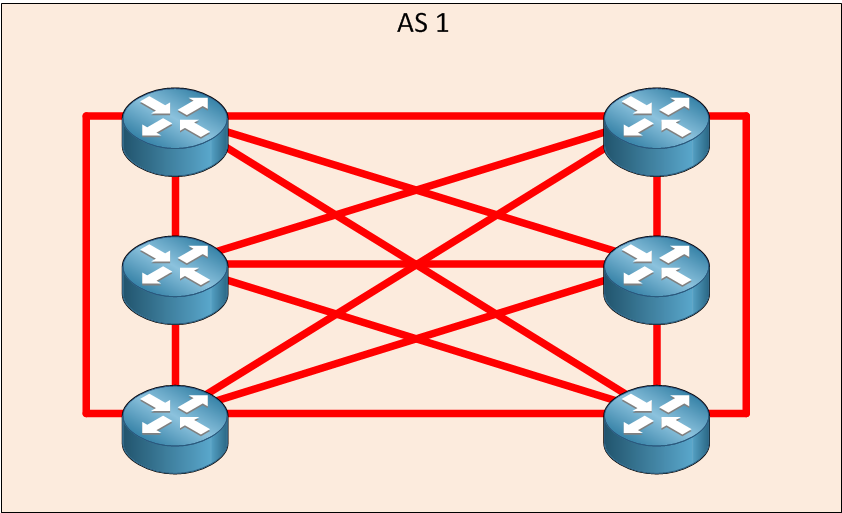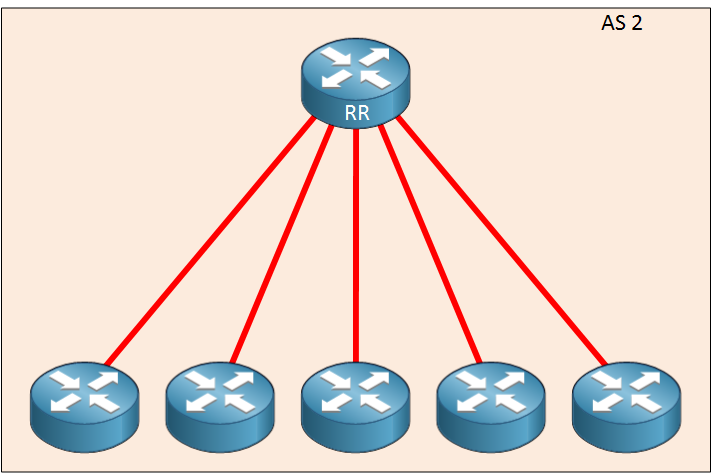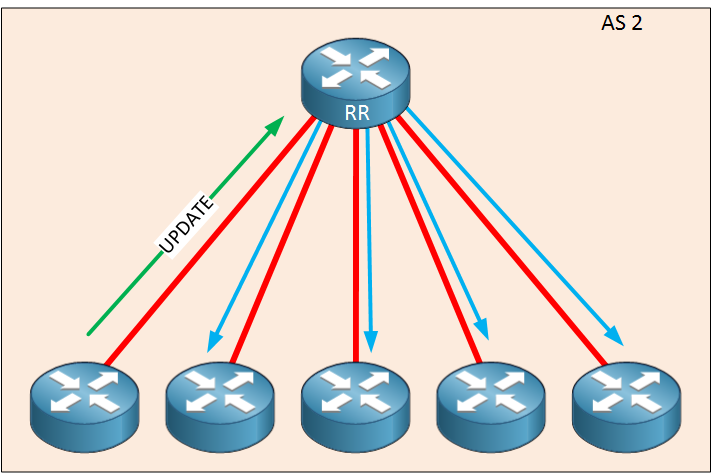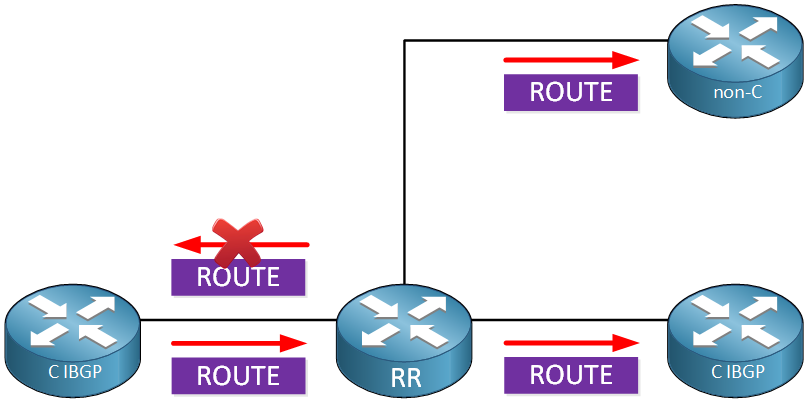Lesson Contents
A BGP route reflector (RR) reduces the need for full-mesh internal BGP (iBGP) peerings in your network. Instead of every iBGP router requiring an iBGP neighbor adjacency with every other iBGP router, routers in the same autonomous system (AS) only have to create a neighbor adjacency with the RR.
The RR “reflects” routing information from one iBGP router to the other iBGP neighbors. This way, no iBGP full-mesh is required. It is a server-client solution where the RR is the server and all other iBGP routers are clients. This simplifies your configuration, reduces the number of iBGP neighbor adjacencies, and also saves CPU and network resources. An alternative method to reduce the number of iBGP neighbor adjacencies is BGP confederations.
Key Takeaways
- A Route Reflector (RR) solves the iBGP scalability problem by removing the need for a full mesh.
- It creates a client-server hierarchy. The RR is the server, and other iBGP routers are configured as route-reflector-clients.
- The RR breaks the standard iBGP split-horizon rule (a route learned from one iBGP peer is not advertised to another iBGP peer).
- To prevent routing loops, the RR uses two special BGP path attributes:
- Originator-ID
- Cluster-List.
- Configuration is straightforward on the RR using the
neighbor <ip-address> route-reflector-clientcommand. Client routers require no special configuration. - A single RR is a single point of failure. We use multiple RRs in a cluster for redundancy.
Prerequisites
To get the most out of this lesson, you should have a good understanding of:
- Basic BGP concepts, including Autonomous Systems (AS) and the difference between iBGP and eBGP.
- The iBGP split-horizon rule.
Scalability
In a large network, the number of iBGP neighbor adjacencies becomes an issue. This is best explained with an example. Take a look at this picture:

Above, we have a network with six IBGP routers. Using the full mesh formula, we can calculate the number of IBGP peerings:
N(N-1)/2
So that will be:
6(6-1=5) / 2 = 15 IBGP peerings.
When we use a route reflector, our network could look like this:

We still have six routers, but each router has only an IBGP peering with the route reflector at the top. When one of those IBGP routes advertises a route to the route reflector, it will be “reflected” to all other IBGP routers:

This simplifies our IBGP configuration a lot, but there’s also a downside. What if the route reflector crashes? It’s a single point of failure when it comes to IBGP peerings. Of course, there’s a solution to this: we can have multiple route reflectors in our network.
RR Peering Types
The route reflector can have three types of peerings:
- EBGP neighbor
- IBGP client neighbor
- IBGP non-client neighbor
When configuring a route reflector, you must tell the router whether the other IBGP router is a client or non-client. A client is an IBGP router to which the route reflector will “reflect” routes. The non-client is just a regular IBGP neighbor.
Rules
When a route reflector forwards a route, there are a couple of rules:
- A route learned from a non-RR client is advertised to RR clients but not to non-RR clients.
- A route learned from an RR client is advertised to both RR clients and non-RR clients. Even the RR client that advertised the route will receive a copy and discard it because it sees itself as the originator.
- A route learned from an EBGP neighbor is advertised to both RR clients and non-RR clients.
Here are three illustrations to see these rules in action.
Rule 1

Rule 2

Rule 3

Configuration
Now that you have an idea of what a route reflector is, let’s take a look at some configurations. We’ll use a simple example, 3 IBGP routers with a single route reflector:

In this example, we have 3 IBGP routers. With normal IBGP rules, when R2 receives a route from R1, it will not be forwarded to R3 (IBGP split horizon). We will configure R2 as the route reflector to get around this. Let’s configure R1 and R3 first:
R1(config)#router bgp 123
R1(config-router)#neighbor 192.168.12.2 remote-as 123R3(config)#router bgp 123
R3(config-router)#neighbor 192.168.23.2 remote-as 123The configuration of R1 and R3 is exactly the same as a normal IBGP peering. Only the configuration on the route reflector is special:
R2(config)#router bgp 123
R2(config-router)#neighbor 192.168.12.1 remote-as 123
R2(config-router)#neighbor 192.168.12.1 route-reflector-client
R2(config-router)#neighbor 192.168.23.3 remote-as 123
R2(config-router)#neighbor 192.168.23.3 route-reflector-clientHere’s the magic…when we configure the route reflector, we have to specify its clients. In this case, R1 and R3. In my topology, I have added a loopback interface on R1. Let’s advertise that in BGP to see what it looks like on R2 and R3:
R1(config)#router bgp 123
R1(config-router)#network 1.1.1.1 mask 255.255.255.255That’s all we have to configure. Let’s use some show commands to verify our work.
Verification
First, we’ll look at R2 and see if it learned anything:
R2#show ip bgp 1.1.1.1
BGP routing table entry for 1.1.1.1/32, version 2
Paths: (1 available, best #1, table Default-IP-Routing-Table)
Flag: 0x820
Advertised to update-groups:
1
Local, (Received from a RR-client)
192.168.12.1 from 192.168.12.1 (1.1.1.1)
Origin IGP, metric 0, localpref 100, valid, internal, bestR2 shows us that this route was received from a route reflector client. Did it advertise anything to R3? Let’s find out:
R2#show ip bgp neighbors 192.168.23.3 advertised-routes
BGP table version is 2, local router ID is 192.168.23.2
Status codes: s suppressed, d damped, h history, * valid, > best, i - internal,
r RIB-failure, S Stale
Origin codes: i - IGP, e - EGP, ? - incomplete
Network Next Hop Metric LocPrf Weight Path
*>i1.1.1.1/32 192.168.12.1 0 100 0 iSo what do we see here? Let me explain…



Hi Rene, all of your BGP Tutorials are so great please make another advanced BGP topics too, such as :
Hi Black,
Glad to hear that you like it. I’ll add some of these tutorials, don’t worry
Rene
Thanks Rene, I’ll be waiting for that.
Hi Rene,
I also want to thank you for BGP tutorials. Its very nicely and simply written.
Thanks Martin!